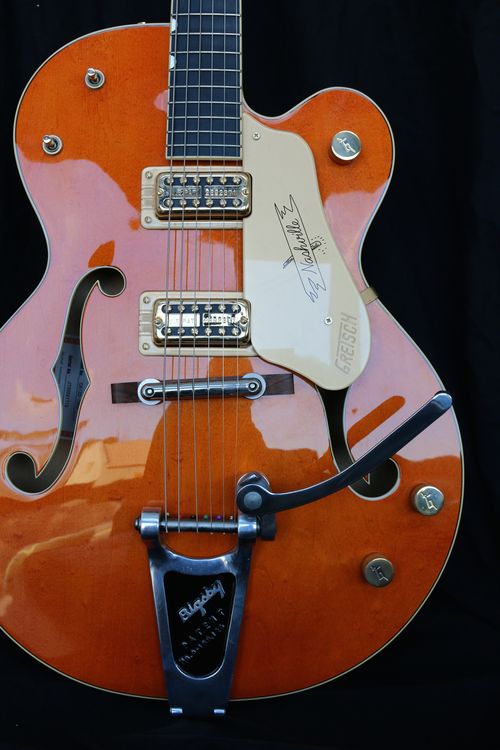ELECTRIC GUITARS
SPRINGER GUITARS FIREHAWK

POSSIBLY THE MOST BEAUTIFUL ELECTRIC GUITAR design…
There are some guitars that just do it for me. The Gibson Firebird has always been that way.
I commissioned this instrument especially for our Starlite.One multimedia project. The music is Art/Prog Rock, so what better instrument to use and it just happens to match the colour of my wifes Mike Lull Starlite T4 bass.
The in depth article I wrote about the process can be found in the link below.
In summary:
- Body: solid body, Spanish cedar, belly cut
- Neck: set neck, Spanish cedar (neck profile: thin ‘C’ -tapers from approx. 21-23 mm
- Headstock veneer: Black fibre, two-steps black/red design
- Fingerboard: 25" scale, aged Indian rosewood with 12'' radius, no binding, cream dot inlays and nickel silver, extra hard frets
- Pickups: two custom wound Firehouse pickups by House of Tone
- Tuners: Kluson style
- Bridge: ABR-1 style with a short Vibrola
- Electronics: two volume, two tone with 500 kΩ potentiometers, .022µF Mallory Mustard capacitors and 3-way toggle switch
- Colour: Cardinal red, nitrocellulose, high gloss
- Pickguard colour: vintage white/parchment with custom logo
- Hardware colour: gloss nickel
- Nut: unbleached bone
- Strung with superb Curt Mangan Nickel wound 11-48.
WHAT DOES IT SOUND LIKE?


BALLS OUT ROCK 'N' ROLL
Every electric player should own a guitar fitted with P90's! Les Paul, Neil Young, George Harrison, Matt Bellamy and countless others have all used guitars fitted with the little blighters.
I fell in love with the sound in 1977 after hearing Danny Kustow playing an Epiphone Coronet in the Tom Robinson Band.
This Les Paul Special custom shop '60 model double cut is my favourite P90 loaded solid body and sold to me by my good friend Rob Livesey. It plays like a dream.
"The Gibson Les Paul Special is a variation of the Gibson Les Paul guitar. It was introduced in 1955 as a model to be an intermediate between the Gibson Les Paul Junior and the more expensive Gibson Les Paul Standard. Like most of Gibsons other budget models, the Special was produced in a TV Yellow finish, which was made by Gibson as a finish that would look good on black and white television. In 1958, the model received a major change when it was introduced as a doublecut model instead of the traditional singlecut.
In 1961, the Les Paul received a drastic change when it was formed into what we know today as the Gibson SG. Once Les Paul's contract had expired later that year, the Les Paul submodels changed with it. In 1968, when the contract was renewed, the original models were rebooted.
P-90 pickups were introduced in 1946 when Gibson resumed guitar production after World War II. They were initially used to replace Gibson's original "bar" or "blade" pickup (also known by many as the "Charlie Christian pickup") on models such as the ES-150, and by the end of the 1940s, it was the standard pickup on all models.
The P-90's reign as the Gibson standard pickup was short-lived, however, as a new design of pickup, the humbucker, was introduced in 1957."
I have been using this for more rocky parts on my new recordings. It sounds remarkable, straight up, through any of my amplifiers.
Using my Germino Classic 45 / Club 40, just link the channels, turn up the bright channel till you get the required amount of breakup, then add some of the normal channel to add body. Cinch.
The only issue I have is the neck joint which, due to the easy access to the 'dusty end' of the neck, allows even moderate pressure to bend it out of tune. Of course, these and all SG's suffer from the same problem but Derek Trucks, Frank Zappa, Duane Allman and Eric Clapton didn't / don't really have a problem, so who am I to comment!
Strung with superb Curt Mangan Nickel wound 11-48
Nothing looks like IT, nothing sounds like it...
The MOOG Guitar Model E1 in black with the additional MIDI interface is now discontinued. It's is tricky to play but perseverance has lent a unique tone and expression to many recordings.
MOOG say: "Since its introduction at the Summer NAMM trade show in 2008, the Moog Guitar has received numerous industry honours including Guitar Player Magazine's 2009 Reader's Choice Award, Electronic Musician Magazine's 2009 Editor's Choice Award, 2008 Summer NAMM "Best In Show" honours, a 2008 “Best of What’s New Award” from Popular Science magazine and a 2009 Mix Foundation TEC Award. More importantly, it has inspired players to new creative heights, and opened the door to totally new forms of expression with a guitar."
Designer Paul Vo visioned that it could be used as a 'standard guitar'. I am afraid he's wrong, but would you want to - nothing else sounds like it!
The pickups, which contain coils to excite or deaden the strings don't cut the mustard and like a sitar or baritone guitar, it's a real specialist, tool. But what a tool...
I used the MOOG on my last solo album 'The Knife' and the Electrolite EP, specifically the middle eight guitar figure in 'Come Home'. For this, I teamed it up with a Stomp Under Foot 'Red Menace' (Big Muff style fuzz) and the Van Weelden TwinkleLand. It is strung with superb Curt Mangan Stainless steel 10, 13, 17, 30, 42, 52.
The example track displays its eerie ambience...
Take a listen and enjoy!
MY WEDDING PRESENT
Not sure why I had never owned a Gretsch before; they sound fantastic!
The build quality of this Japanese reissue is exceptional with sustain to die for with a great balanced tone somewhere between a single coil and humbucker hollow body
This is a very special guitar as it was a wedding present from my wife and musical partner Suzy Starlite!
Originally launched in the mid-'50s, the 6120 has gone on to become legendary, played by Chet Atkins, Eddie Cochran, Neil Young, Pete Townshend and Brian Setzer to name a few.
I replaced the pickups with TV Jones 'Classic' and disconnected the tone switch as I kept hitting it in the heat of battle which is very irritating. It's been used on many gigs, but as yet never made it to a record.
Now strung with Pyramid Gold Flatwound strings 011-050 this wonderful instrument sounds best with the Gartone Vibrato King (an exact clone of a 3 x 10" Fender Bandmaster) and Gartone Reverb King (an exact clone of a 1965 blackface Fender Bandmaster).
You will have to wait a bit to hear it recorded, but when you do, you will like it :)
WHAT DOES IT SOUND LIKE
Track to follow!

Classic Fender action...
I bought this guitar for my eldest son Jim's 21st birthday from the very wonderful Richard Henry. Jim is more of an acoustic player and after a couple of years, we swapped. He had my Taylor GA limited edition and I bagged the Telecaster - we both had a great deal out of it!
I use this on both my solo records, ThirtySix, The Knife and extensively with Starlite Campbell Band!
Strung with Curt Mangan Starlite Campbell Band custom nickel wound 11-48, it's my go-to guitar, sounds wonderful and plays beautifully even though the neck is like a tree trunk.
Leo Fender just got it right first time with the design of the tuning pegs, pickups and body design; yes, I suppose everything!
Played through my 1962 VOX AC30, 'Lay It Out On Me' is a good example of the tone.
WHAT DOES IT SOUND LIKE?

My signature guitar
After 'meeting' on Facebook via my dear friend and ace guitar player Dave Lang, Jim asked if he could build me a guitar. I, of course, said yes and he indulged me in designing it from scratch!
When it was finished it was clear that Jim is not only a fine guitar builder, as this is only part of the story. He takes a genuine interest in you as an artist, crafting instruments that suit not only your playing style and specification but also your musicality, your soul.
I am known principally for Telecasters but have always hankered after a great semi-acoustic. Years ago I owned a 1958 Epiphone Riviera, which was very cool but never really got on with the 'mini humbuckers'.
It's a strange feeling designing a guitar from the ground up as you need to really think about what you want in every detail. I opted for a chambered body and Jim recommended sycamore, with ash in the centre. The neck is quarter-sawn mahogany on the outside and flat-sawn maple in the middle, flanked by purple heart with a fingerboard of Macassar ebony.
Pickups are Sheptone 'Blue Sky' PAF's with three CTS volume pots, one tone, Graph Tech Ratio tuning pegs, nut and bridge, a six-way NSF controls freeway six-position switch and standard Bigsby tremolo unit.
The sound is, as you would expect, woody with loads of sustain and performs amazingly with the Germino Classic 45 / Club 40 and 4x12. All featured in the adjacent rig rundown.
THE LUXURY OF TWO OPEN TUNINGS
Lap/pedal steels are everywhere in music that I love. From Daniel Lanois, Dave Gilmour to Steve Howe and Ted Turner. I do like to play slide but the sustain you get from a lap steel is something else.
My first was a cream 1961 Gretsch Electromatic D6 Console (double lap steel) guitar 1961, but following the fabulous experience with Jim Drake, I asked him to make me one.
This is a wonderful instrument fitted with two Lollar 'String Through Steel' pickups (copy of the Supro®/Oahu/Valco) and Graph Tech Ratio Tuning pegs. Funnily enough, both necks sound totally different and I set the tunings to suit. Usually an open G (D,G,D,G,B,D) and open D (D,G.D,F#,A,D).
Used straight into my Speed Shop Tweed Deluxe or with a combination of Origin Effects Cali76 Fulltone OCD, Stomp Under Foot Red Menace it sounds awesome.
Strung as you would expect with Curt Mangan Nickel wound 16-56.



















